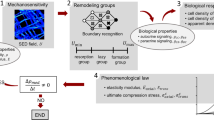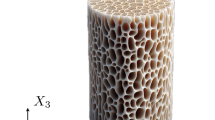Abstract
The formation of different tissues in the callus during secondary bone healing is at least partly influenced by mechanical stimuli. We use computer simulations to test the consequences of different hypotheses of the mechanoregulation at the cellular level on the patterns of tissues formed during healing. The computational study is based on an experiment on sheep, where after a tibial osteotomy, histological sections were harvested at different time points. In the simulations, we used a recently proposed basic phenomenological model, which allows ossification to occur either via endochondral or intramembranous ossification, but tries otherwise to employ a minimal number of simulation parameters. The model was extended to consider also the possibility of bone resorption and consequently allowing a description of the full healing progression till the restoration of the cortex. Specifically, we investigated how three changes in the mechanoregulation influence the resulting tissue patterns: (1) a time delay between stimulation of the cell and the formation of the tissue, (2) a variable mechanosensitivity of the cells, and (3) an independence of long time intervals of the soft tissue maturation from the mechanical stimulus. For all three scenarios, our simulations do not show qualitative differences in the time development of the tissue patterns. Largest differences were observed in the intermediate phases of healing in the amount and location of the cartilage. Interestingly, the course of healing was virtually unaltered in case of scenario (3) where tissue maturation proceeded independent of mechanical stimulation.








Similar content being viewed by others
References
Bastian P, Blatt M, Dedner A, Engwer C, Klofkorn R, Ohlberger M, Sander O (2008) A generic grid interface for parallel and adaptive scientific computing. Part I: abstract framework. Computing 82(2–3):103–119
Burger EH, Klein-Nulend J, Veldhuijzen JP (1992) Mechanical stress and osteogenesis in vitro. J Bone Miner Res 7(Suppl 2):S397–S401
Burke DP, Kelly DJ (2012) Substrate stiffness and oxygen as regulators of stem cell differentiation during skeletal tissue regeneration: a mechanobiological model. PLoS ONE 7(7):e40737. doi:10.1371/journal.pone.0040737
Byrne DP, Lacroix D, Prendergast PJ (2011) Simulation of fracture healing in the tibia: mechanoregulation of cell activity using a lattice modeling approach. J Orthop Res 29(10):1496–1503. doi:10.1002/jor.21362
Checa S, Prendergast PJ (2009) A mechanobiological model for tissue differentiation that includes angiogenesis: a lattice-based modeling approach. Ann Biomed Eng 37(1):129–145. doi:10.1007/s10439-008-9594-9
Checa S, Prendergast PJ, Duda GN (2011) Inter-species investigation of the mechano-regulation of bone healing: comparison of secondary bone healing in sheep and rat. J Biomech 44(7):1237–1245
Claes L, Heigele C (1999) Magnitudes of local stress and strain along bony surfaces predict the course and type of fracture healing. J Biomech 32(3):255–266. doi:10.1016/S0021-9290(98)00153-5
Currey J (1995) The validation of algorithms used to explain adaptive bone remodeling in bone. In: Odgaard A, Weinans H (eds) Bone structure and remodeling. World Scientific, Singapore, pp 9–13
Duda GN, Eckert-Hübner K, Sokiranski R, Kreutner A, Miller R, Claes L (1997) Analysis of inter-fragmentary movement as a function of musculoskeletal loading conditions in sheep. J Biomech 31(3):201–210
Einhorn TA (1998) The cell and molecular biology of fracture healing. Clin Orthop Relat Res 355:S7–S21
Engler AJ, Sen S, Sweeney HL, Discher DE (2006) Matrix elasticity directs stem cell lineage specification. Cell 126(4):677–689. doi:10.1016/j.cell.2006.06.044
Epari DR, Schell H, Bail HJ, Duda GN (2006) Instability prolongs the chondral phase during bone healing in sheep. Bone 38(6):864–870. doi:10.1016/j.bone.2005.10.023
Fratzl P, Weinkamer R (2007) Nature’s hierarchical materials. Prog Mater Sci 52(8):1263–1334. doi:10.1016/j.pmatsci.2007.06.001
Garcia P, Histing T, Holstein J, Klein M, Laschke M, Matthys R, Ignatius A, Wildemann B, Lienau J, Peters A et al (2013) Rodent animal models of delayed bone healing and non-union formation: a comprehensive review. Eur Cells Mater 26:1–14
Garzon-Alvarado DA, Gutiérrez ML2, Calixto LF (2014) A computational model of clavicle bone formation: a mechano-biochemical hypothesis. Bone 61:132–137
Geris L, Gerisch A, Sloten JV, Weiner R, Oosterwyck HV (2008) Angiogenesis in bone fracture healing: a bioregulatory model. J Theor Biol 251(1):137–158. doi:10.1016/j.jtbi.2007.11.008
Geris L, Vander Sloten J, Van Oosterwyck H, Geris L, Vander Sloten J, Van Oosterwyck H (2009) In silico biology of bone modelling and remodelling: regeneration. Philos Trans R Soc A 367(1895):2031–2053. doi:10.1098/rsta.2008.0293
Geris L, Vandamme K, Naert I, Sloten JV, Van Oosterwyck H, Duyck J (2010) Mechanical loading affects angiogenesis and osteogenesis in an in vivo bone chamber: a modeling study. Tissue Eng A 16(11):3353–3361
Gerstenfeld LC, Alkhiary YM, Krall EA, Nicholls FH, Stapleton SN, Fitch JL, Bauer M, Kayal R, Graves DT, Jepsen KJ, Einhorn TA (2006) Three-dimensional reconstruction of fracture callus morphogenesis. J Histochem Cytochem 54(11):1215–1228. doi:10.1369/jhc.6A6959.2006 PMID: 16864894
Gibson LJ, Ashby MF (1999) Cellular solids: structure and properties. Cambridge University Press, Cambridge
Gómez-Benito M, Garcia-Aznar J, Kuiper J, Doblare M (2005) Influence of fracture gap size on the pattern of long bone healing: a computational study. J Theor Biol 235(1):105–119. doi:10.1016/j.jtbi.2004.12.023
Gómez-Benito MJ, González-Torres LA, Reina-Romo E, Grasa J, Seral B, García-Aznar JM, Gómez-Benito MJ, González-Torres LA, Reina-Romo E, Grasa J, Seral B, García-Aznar JM (2011) Influence of high-frequency cyclical stimulation on the bone fracture-healing process: mathematical and experimental models. Philos Trans R Soc A 369(1954):4278–4294. doi:10.1098/rsta.2011.0153
Groothuis A, Duda GN, Wilson CJ, Thompson MS, Hunter MR, Simon P, Bail HJ, van Scherpenzeel KM, Kasper G (2010) Mechanical stimulation of the pro-angiogenic capacity of human fracture haematoma: involvement of VEGF mechano-regulation. Bone 47:438–444
Henderson JH, Carter DR (2000) Mechanical induction in limb morphogenesis: the role of growth-generated strains and pressures. J Orthop Res 18:829–834
Hori RY, Lewis JL (1982) Mechanical properties of the fibrous tissue found at the bone–cement interface following total joint replacement. J Biomed Mater Res 16(6):911–927. doi:10.1002/jbm.820160615
Huang C, Ogawa R (2012) Effect of hydrostatic pressure on bone regeneration using human mesenchymal stem cells. Tissue Eng Part A 18:2106–2113
Isaksson H, van Donkelaar CC, Huiskes R, Ito K (2006) Corroboration of mechanoregulatory algorithms for tissue differentiation during fracture healing: comparison with in vivo results. J Orthop Res 24(5):898–907. doi:10.1002/jor.20118
Isaksson H, Wilson W, van Donkelaar CC, Huiskes R, Ito K (2006) Comparison of biophysical stimuli for mechano-regulation of tissue differentiation during fracture healing. J Biomech 39(8):1507–1516. doi:10.1016/j.jbiomech.2005.01.037
Isaksson H, van Donkelaar CC, Huiskes R, Ito K (2008) A mechano-regulatory bone-healing model incorporating cell-phenotype specific activity. J Theor Biol 252(2):230–246. doi:10.1016/j.jtbi.2008.01.030
Isaksson H (2012) Recent advances in mechanobiological modeling of bone regeneration. Mech Res Commun 42:22–31
Kasper G, Glaeser JD, Geissler S, Ode A, Tuischer J, Matziolis G, Perka C, Duda GN (2007) Matrix metalloprotease activity is an essential link between mechanical stimulus and mesenchymal stem cell behavior. Stem Cells 25(8):1985–1994. doi:10.1634/stemcells.2006-0676
Kelly DJ, Jacobs CR (2010) The role of mechanical signals in regulating chondrogenesis and osteogenesis of mesenchymal stem cells. Birth Defects Res Embryo Today Rev 90(1):75–85. doi:10.1002/bdrc.20173
Khayyeri H, Checa S, Tägil M, Aspenberg P, Prendergast PJ (2011) Variability observed in mechano-regulated in vivo tissue differentiation can be explained by variation in cell mechano-sensitivity. J Biomech 44(2011):1051–1058. doi:10.1016/j.jbiomech.2011.02.003
Khayyeri H, Isaksson H, Prendergast PJ (2013) Corroboration of computational models for mechanoregulated stem cell differentiation. Comput Methods Biomech Biomed Eng 1–9. doi:10.1080/10255842.2013.774381
Kollmannsberger P, Bidan CM, Dunlop JWC, Fratzl P (2011) The physics of tissue patterning and extracellular matrix organisation: how cells join forces. Soft Matter 7(20):9549–9560. doi:10.1039/C1SM05588G
Lacroix D, Prendergast P (2002) A mechano-regulation model for tissue differentiation during fracture healing: analysis of gap size and loading. J Biomech 35(9):1163–1171. doi:10.1016/S0021-9290(02)00086-6
Lacroix D, Prendergast PJ, Li G, Marsh D (2002) Biomechanical model to simulate tissue differentiation and bone regeneration: application to fracture healing. Med Biol Eng Comput 40(1):14–21. doi:10.1007/BF02347690
Manjubala I, Liu Y, Epari D, Roschger P, Schell H, Fratzl P, Duda G (2009) Spatial and temporal variations of mechanical properties and mineral content of the external callus during bone healing. Bone 45(2):185–192
Maul TM, Chew DW, Nieponice A, Vorp DA (2011) Mechanical stimuli differentially control stem cell behavior: morphology, proliferation, and differentiation. Biomech Model Mechanobiol 10(6):939–953
Morgan EF, Bayraktar HH, Keaveny TM (2003) Trabecular bone modulus–density relationships depend on anatomic site. J Biomech 36(7):897–904. doi:10.1016/S0021-9290(03)00071-X
Park JS, Chu JS, Cheng C, Chen F, Chen D, Li S (2004) Differential effects of equiaxial and uniaxial strain on mesenchymal stem cells. Biotechnol Bioeng 88:359–368
Pauwels F (1960) Eine neue theorie ueber den einfluss mechanischer reize auf die differenzierung der stuetzgewebe. Anat Embryol 121(6):478–515. doi:10.1007/BF00523401
Pelaez D, Arita N, Cheung HS (2012) Extracellular signal-regulated kinase (ERK) dictates osteogenic and/or chondrogenic lineage commitment of mesenchymal stem cells under dynamic compression. Biochem Biophys Res Commun 417:1286–1291
Perren S, Cordey J (1980) The concept of interfragmentary strain. In: Uhthoff H (ed) Current concepts of internal fixation of fractures. Springer, Berlin, pp 67–77O
Reichert JC, Saifzadeh S, Wullschleger ME, Epari DR, Schütz MA, Duda GN, Schell H, van Griensven M, Redl H, Hutmacher DW (2009) The challenge of establishing preclinical models for segmental bone defect research. Biomaterials 30(12):2149–2163. doi:10.1016/j.biomaterials.2008.12.050
Reina-Romo E, Gómez-Benito M, Domínguez J, Niemeyer F, Wehner T, Simon U, Claes L (2011) Effect of the fixator stiffness on the young regenerate bone after bone transport: computational approach. J Biomech 44(5):917–923. doi:10.1016/j.jbiomech.2010.11.033
Schell H, Thompson MS, Bail HJ, Hoffmann JE, Schill A, Duda GN, Lienau J (2008) Mechanical induction of critically delayed bone healing in sheep: radiological and biomechanical results. J Biomech 41(14):3066–3072. doi:10.1016/j.jbiomech.2008.06.038
Schmidt-Bleek K, Schell H, Schulz N, Hoff P, Perka C, Buttgereit F, Volk HD, Lienau J, Duda GN (2011) Inflammatory phase of bone healing initiates the regenerative healing cascade. Cell Tissue Res 347(3):567–573. doi:10.1007/s00441-011-1205-7
Steiner M, Claes L, Ignatius A, Niemeyer F, Simon U, Wehner T (2013) Prediction of fracture healing under axial loading, shear loading and bending is possible using distortional and dilatational strains as determining mechanical stimuli. J R Soc Interface 10(86). doi:10.1098/rsif.2013.0389
Subramony SD, Dargis BR, Castillo M, Azeloglu EU, Tracey MS, Su A, Lu HH (2013) The guidance of stem cell differentiation by substrate alignment and mechanical stimulation. Biomaterials 34(8):1942–1953
Vetter A, Epari DR, Seidel R, Schell H, Fratzl P, Duda GN, Weinkamer R (2010) Temporal tissue patterns in bone healing of sheep. J Orthop Res 28(11):1440–1447. doi:10.1002/jor.21175
Vetter A, Liu Y, Witt F, Manjubala I, Sander O, Epari D, Fratzl P, Duda G, Weinkamer R (2011) The mechanical heterogeneity of the hard callus influences local tissue strains during bone healing: a finite element study based on sheep experiments. J Biomech 44(3):517–523. doi:10.1016/j.jbiomech.2010.09.009
Vetter A, Witt F, Sander O, Duda GN, Weinkamer R (2012) The spatio-temporal arrangement of different tissues during bone healing as a result of simple mechanobiological rules. Biomech Model Mechanobio 11(1–2):147–160. doi:10.1007/s10237-011-0299-x
Wang JC, Thampatty B (2006) An introductory review of cell mechanobiology. Biomech Model Mechanobiol 5(1):1–16. doi:10.1007/s10237-005-0012-z
Wang N, Tytell JD, Ingber DE (2009) Mechanotransduction at a distance: mechanically coupling the extracellular matrix with the nucleus. Nat Rev Mol Cell Biol 10(1):75–82
Acknowledgments
This study was supported by a grant of the German Research Foundation (Collaborative Research Centre “Biomechanics and Biology of Musculoskeletal Regeneration—From Functional Assessment to Guided Tissue Formation”, SFB 760). The authors like to thank Maria Gómez-Benito and Philip Kollmannsberger for fruitful discussions and Oliver Sander for his support with the finite element solver.
Author information
Authors and Affiliations
Corresponding author
Electronic supplementary material
Below is the link to the electronic supplementary material.
Supplementary material 1 (mpg 2081 KB)
Rights and permissions
About this article
Cite this article
Repp, F., Vetter, A., Duda, G.N. et al. The connection between cellular mechanoregulation and tissue patterns during bone healing. Med Biol Eng Comput 53, 829–842 (2015). https://doi.org/10.1007/s11517-015-1285-8
Received:
Accepted:
Published:
Issue Date:
DOI: https://doi.org/10.1007/s11517-015-1285-8




